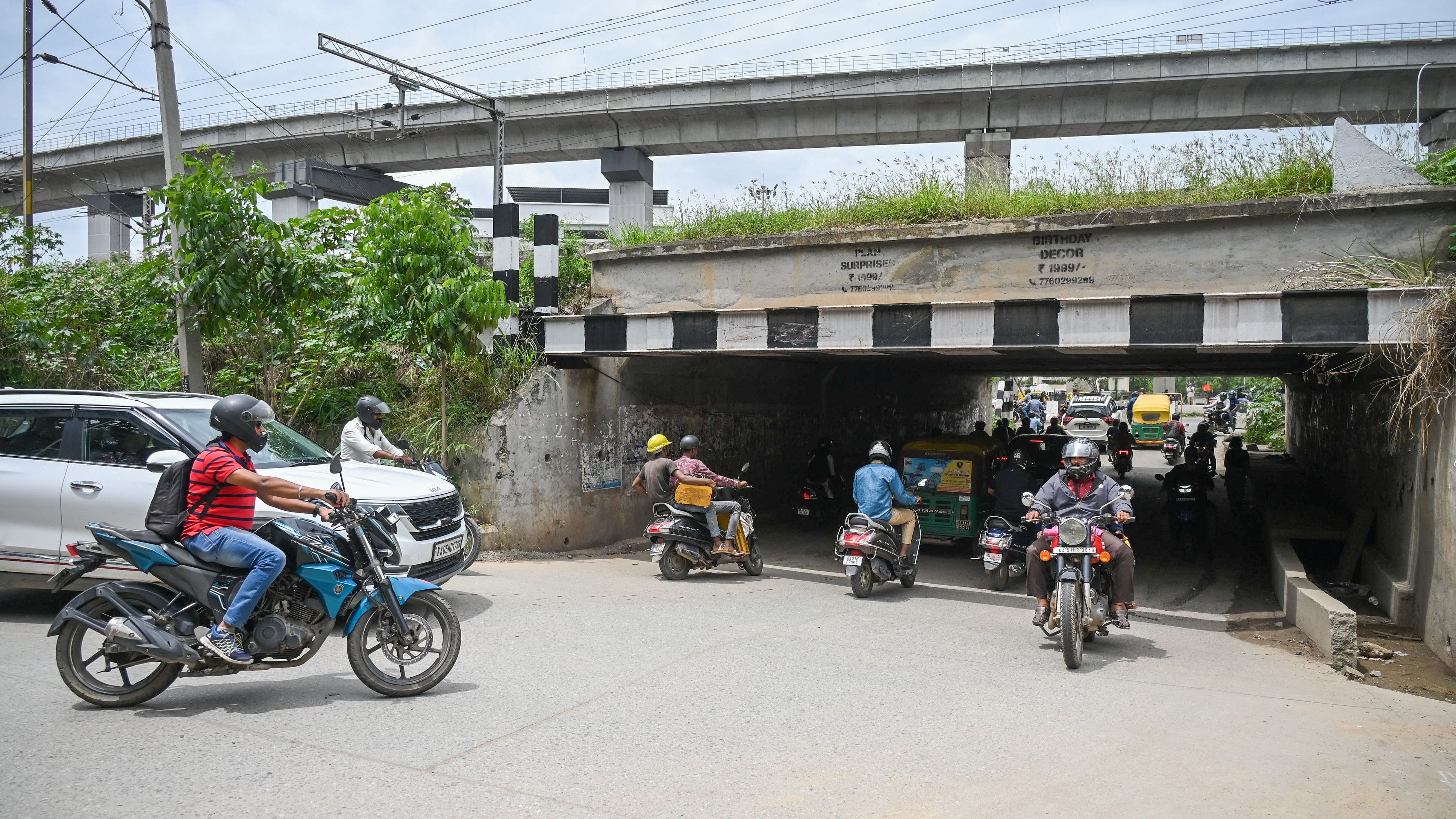
Vehicles continue to navigate through this narrow underpass at KR Puram.
DH Photos/ S K Dinesh
Bengaluru: With the southwest monsoon becoming active in Bengaluru, poor road infrastructure and badly maintained railway underbridges (RUBs) remain a potential deathtrap for pedestrians, vehicle users and daily commuters.
Widespread waterlogging, coupled with a slow municipal response, creates traffic jams, exacerbating the already dangerous and poorly maintained “magic box” RUBs. These structures, like the narrow one in Kasturi Nagar opening towards Old Madras Road, become especially hazardous during the monsoon.
The low-lying, slightly bent RUB in Kasturi Nagar is prone to severe waterlogging, worsened by debris, plastic waste and other trash obstructing the free flow of water in roadside drains.
Surrounding this RUB are the Purva Midtown apartment complex, individual houses and two important metro stations on the Purple Line — Benniganahalli and Baiyappanahalli. Vehicle users blame the “narrow and flawed” design of the underbridge, which they say becomes a bottleneck and a severe hazard during heavy rainfall due to delays in water removal.
Kalpana, a 35-year-old resident of Kasturi Nagar who generally takes her son to a tuition class through the RUB, remains home during heavy rains, fearing she will get submerged in the accumulated water and lose her son. While she acknowledges Bruhat Bengaluru Mahanagara Palike (BBMP) workers’ efforts to clear the water, she says it takes three to four hours for the situation to normalise. Another pedestrian reported rainwater accumulation of three to four feet over a 50-meter stretch during heavy rains.
This reporter recently visited RUBs in Okalipuram, KR Puram, Dooravani Nagar, Kasturi Nagar, Doddanekundi, Seshadripuram, Banaswadi, Lingarajapuram and Marathahalli. The visit revealed the basic problems: roadside drains filled with debris and plastic waste, alongside their narrow design, typically known as “magic box.”
“The word ‘bottleneck’ would be an understatement for the Panathur underpass. I have even seen ambulances getting stuck here during peak hours. It takes a minimum of 15-20 minutes (up to 90 minutes at times) to cross this at any time of the day, let alone during the rain. Once it rains, vehicular movement comes to a standstill. Waterlogging is a common sight. Since two-way movement is not possible, the traffic police stop vehicular movement on one side from Kadubeesanahalli and one from Panathur. Despite this, I have seen vehicles move in three lanes in one direction without paying heed to rules, leading to total chaos. Since the road connects to the IT corridor, mornings and evenings are terrible, to say the least,” said Ajith, an area resident.
Last year’s tragic death of a 23-year-old woman at the KR Circle underpass in the heat of the city should have been a wake-up call for authorities. Yet, images of vehicles wading through these narrow, flooded underpasses remain etched in Bengalureans’ memories. Many residents believe the primary issue is poor maintenance, compounded by the flawed, box-like design of these underpasses.
Durgamma, who walks to work via the RUB near Banaswadi railway station, said she was “frightened” by the rains not only because of the flooding of her usual route but also because of the congestion caused by two-wheelers, vehicles and cows that go helter-skelter during heavy rains. She said homeless people take shelter under the RUB and she was concerned about their safety.
Gunashekaran, a motorcyclist in Lingarajapuram, another notorious flood-prone RUB, told DH, “The pumping out of accumulated water by BBMP workers itself leads to further congestion in the area.”
Sanjeev Dyamannavar, an urban infrastructure activist, believes that continuous monitoring of flood-prone RUBs, especially in eastern Bengaluru, is crucial to preventing flooding, traffic jams and the risk of accidents and deaths. “It is alarming that these underbridges get flooded even with moderate rainfall, let alone heavy rains. However, the authorities do not seem to raise any concern on the safety of commuters or ensuring that the low-lying areas do not get flooded,” he said.
According to him, “Whenever we get heavy rain forecasts, officers should be on their toes to ensure that all the flood regulation systems are in place. For instance, the plastic and construction debris on roadside drains must be cleared out before the heavy rain alert to ensure water flows and does not accumulate.” He added that the RUBs in Jakkur and Mathikere also get flooded invariably.
A senior official in the South Western Railway’s Bengaluru division insisted that “no design flaws” were noticed in the RUBs but conceded that there were issues related to waterlogging. According to the official, steps have been taken to re-examine their drainage arrangement and carry out the necessary repair work before the monsoon.
Rainwater harvesting, injection wells and automatic pumping systems have been installed at these locations as per the requirement. The daily waterlogging status will be monitored round the clock during the monsoon. We will make sure that the issue is attended to immediately,” the official told DH.
Some RUBs are maintained by the railways, while others are managed by state government agencies such as the BBMP and BDA to address waterlogging issues, according to the official.
FUNDS & MAINTENANCE
No of RUBs in Bengaluru: 102
Money spent by railways on RUBs: Rs 256 cr
Railways plans to build 15 more RUBs in lieu of level crossings Railways is responsible for the design & construction of RUBs Railways BBMP & BDA are responsible for maintenance